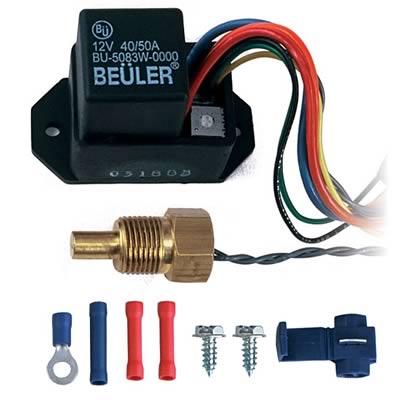DanWheeler
Bronco Guru
is 185 on, 170 off the proper range for a thermostatic fan switch in the water neck?
they have a 200 on, 180 off but that seems too high
they have a 200 on, 180 off but that seems too high





Too bad there isn't a way to use the same sensor for a temperature gauge and the fan thermostat. With the thermostat for the fan i'll be monitoring temperatures in 3 different places. (ECT, fan switch and gauge)
is 185 on, 170 off the proper range for a thermostatic fan switch in the water neck?
they have a 200 on, 180 off but that seems too high
Mark try High,low, and off.
I'd like to wire up an alarm in case my switch gets bumped from auto to off.
here's what I'm thinking - please let me know if there is an easier way to do this.
I think I can use a SPDT relay and a piezo buzzer of some sort to make a noise whenever the 3 way switch is in the off position. If i connect both "on" terminals of the switch to the 85 side of the coil (86 goes to ground) and use diodes to isolate them then I could connect 12v to the common terminal (30) and connect the piezo alarm to the normally closed terminal on the relay then when the switch is on either of the on positions (auto or high) it will trigger the relay causing the alarm circuit to open and turn off.
Will that work or is there an easier way to do it?
thanks,
dan
You can look at the diagram I have here. It might give you an idea. The amber light comes on when the fan is turned OFF.
http://classicbroncos.com/tech/liberty-electric-fan-for-your-early-bronco
ViperWolf, note sure if you are watching but I have a fuse question. Does your formula for figuring out relay amperage apply to fuses as well? For a fuse does it need to multipled by 2?
I have a junkyard Ford fusebox that has 50 amp maxi fuses and some heavy gauge wire. Do you think a 50 amp fuse would be sufficient?
Also, are fuses supposed to go on the battery side or the accessory side of a relay?
thanks
dan
Yes. 50 amp on the low side and 70 amp on the high side should work for you. You might be able to get by with some smaller fuses if you experiment with extras. It all depends on what the motor is pulling at startup. If you don't have provisions for a 70 amp in the fusebox you can wire it with two 35 amp fuses in parallel. I'd fuse the battery side of the relay. It protects more of the circuit that way.







